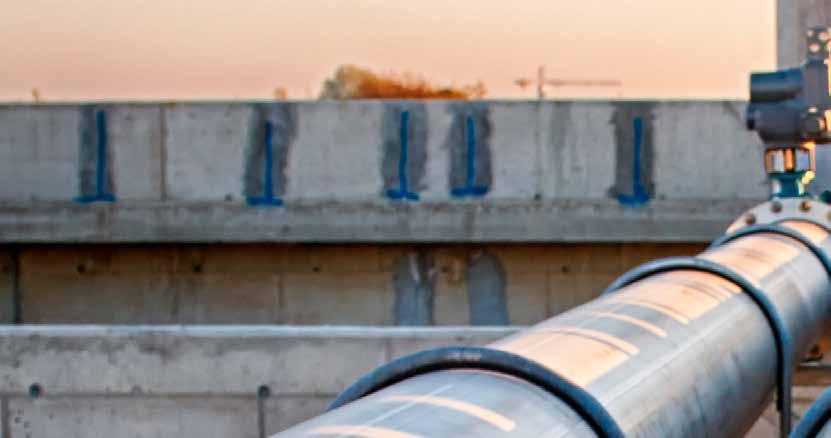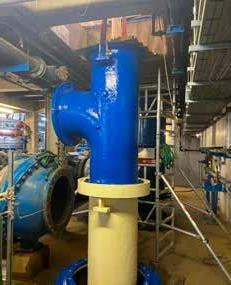
6 minute read
When ‘right first time’ is the only option
Derek Ashburn Application Engineer Pump Services
Hindsight is a wonderful thing. If only we had the ability to foresee issues before we encounter them. Having a better understanding of a challenge from the beginning would be a bonus, but we all know, that’s often not an option we are afforded with.
Advertisement
Many large-scale projects leave very little room for error. Not only is the customer looking for a speedy resolution as downtime can cause serious issues, but your reputation is also at risk. As an engineering services provider, people are placing their trust in you to deliver. So, ‘right first time’ is the only option. ERIKS were recently involved in a project with a water company that was experiencing issues with one of its river abstraction pumps. A series of condition checks were carried out resulting in ERIKS Specialist Engineering Services being enlisted to support the fullscale overhaul programme of both the pump and motor.
The water company had a history of working alongside other service providers, with one of the sister pumps having been out for repair for over a year. This and relatively short MTBF was worryingly short for these types of units. As is often the case there was very little in the way of repair history, original drawings, or parts lists to support the repair process, so much of the procedure and assessment was going to rely on experience and sound engineering best practice. As you can appreciate, this was a significant challenge – but one ERIKS did not hesitate to accept. The challenges were building up
The pump in question dated back to the early ‘70s, and as we know, ageing assets come with their own risks, particularly, those that operate in arduous conditions. Exposure to silt and foreign objects in the water stream was a constant issue, with poor suction conditions also causing cavitation damage along with erosion problems. With the initial inspection and scoping of the task complete, a quality plan was drawn up; it was now time for removal which was a huge operation in its own right. Removing the pump-set involved partial dismantling of the unit into sub-sections. In these cases, you are relying on key skills within your team, fundamentally - experience, meticulous engineering know-how, and safe systems of work. Understanding all the health and safety risks with electrical and mechanical disconnection was essential. Up front, detailed risks assessments and methods statements were required, so that the team knew exactly what to expect, how to execute the work, and how to mobilise for operation. On top, it was pivotal to understand and adhere to relevant legislation, internal health and safety rule, and those of the customers, including testing and proving for dead/ LOTO regulations and PTW (Permit to Work) compliance. Working in an unfamiliar environment poses its own risks, and itself an ever-changing landscape, therefore must also be constantly assessed and re-appraised via POWRA (Power of Work Risk Assessments. Say what you see
With removal and transportation completed, our Chesterfield Engineers were all set to inspect and produce the condition report. The findings of the initial examination discovered that the OEM had used different impellers to achieve the duty requirement while boosting suction performance, even so there was evidence suggesting that the pump had been running with very low NPSHa, resulting in serious cavitation damage on the first stage impeller and bowl vanes. The second impeller was also showing excessive amounts of residual weld on one of the vanes, this had been left over from a previous repair. More seriously however, the upper drive shaft had snapped through fatigue due to an incorrect machined taper angle from a previous repair within the coupling Recommend. Overhaul. Repair
Due to the age and history of this type of equipment, it is likely that these units will have been repaired several times during their lifecycle, often without any records or history surrounding the work that has been carried



out. As in all cases, it is vitally important that the design, components used, and material selection is not taken as found, there are many pitfalls in “copy repairs” and unproven modifications. You will also find that many of the materials used in the original design may not comply with current guidelines or legislation. Indeed, there are many new materials that can be utilised to increase reliability, improve efficiency, and extend service life!
For example, many of these pumps contained asbestos based composites or alloys with very high lead content, both of which are no longer compliant with the latest regulations. As expected with obsolete equipment there are no off-the-shelf spares available, so several major components needed to be reverse engineered and manufactured from scratch.
A 3D scan of the pump was completed facilitating the re-manufacture of the spare parts and assisting in building a 3D computer model, this method can be utilised to assess the components fits and tolerances and serves the purpose to create new drawings and establish electronic records that can be sourced for future use.
To improve pump efficiency, and reduce erosion/corrosion, all the column pipes, pump bowl and flare, transmission bearing carrier, discharge bend and head gear were coated with Belzona 1341 which is also DWI compliant. The full scope of parts manufacturing included: special transmission bearing sleeve, transmission bearing bushes, stage casing bushes, bearing sleeves, impeller wear rings, threaded gland sleeve nut, drive shafts and tapered couplings. In terms of repair, the Chesterfield team addressed the impeller issues by NDT, checking for any flaws, perforations, and fatigue cracks as well as repairing the previous weld. Cavitation on the vane tips was also dressed and repaired, before manufacturing a mandrel and balancing. To finish, condition monitoring apparatus was installed so that the customer had a clear view of the applications performance upon reinstallation. This provides the benefit of “bench marking” performance on commissioning allowing the customer to monitor any future performance degradation against the “as repaired” readings, allowing them to foresee any potential problems as they occur rather than when it’s too late. Delivered with savings. Bonus
A thorough overhaul and refurbishment can often provide the performance, reliability, and efficiency benefits that new plant provides at a fraction of the cost, significant populations of legacy equipment are very well engineered and certainly built to last. By restoring manufacturers design clearances and utilising modern materials and compounds, pump efficiency can be restored and marginally enhanced with significant reductions in life cycle costs. We would expect an efficiency improvement for this type of repair to be in the region of 12 to 15% and given the size of drive unit that becomes very important as utilisation increases. In addition, reverse engineering the components means that this asset remains viable even though it would have been classed as officially obsolete. Some manufacturers will offer support for such equipment, but this can be very costly and involve un-realistic delivery times. The process that ERIKS offer saves significant time and money while providing the opportunity to uprate the materials utilised. From initial inspection to re-installation, the project took around seven months to completion. And given the government restrictions imposed for the second national COVID lockdown, it’s an even more impressive feat.











